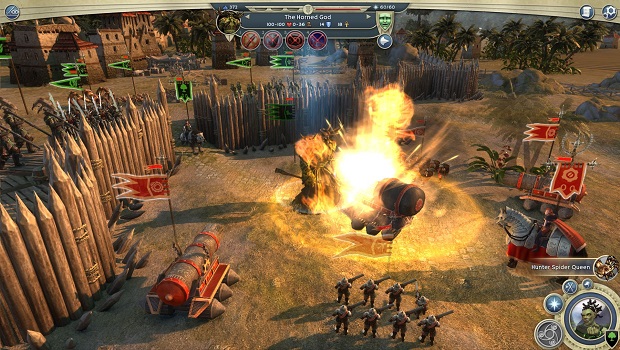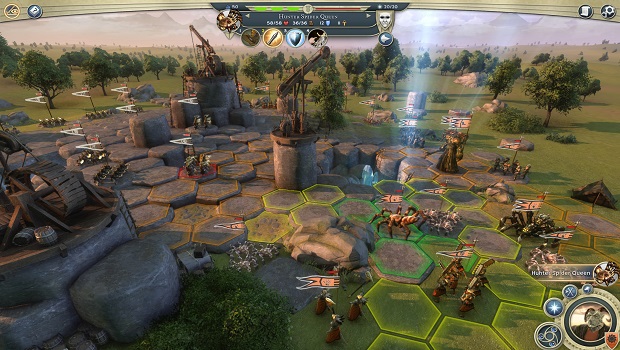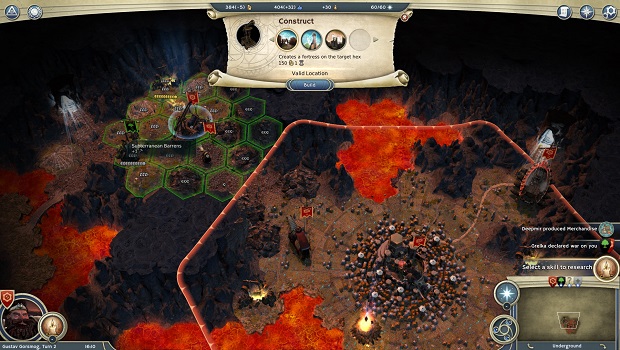Games of conquest with equally well formed strategic level management and tactical combat components have long been the holy grail of strategy games for me. Ever since my original experience with Shogun Total War, I’ve sought out games that allowed me to both manage a growing empire, and experience conquests on the ground. The Age of Wonders series has long been a hallmark of the fantasy offshoot of the genre. After an absence of nearly a decade, the series returns with the new Age of Wonders 3.
Age of Wonders 3 is a strategy game simulating campaigns of conquest in a fantasy kingdom. It is quintessential 4x in nature, as you found your empire, grow your borders, gather resources and research news spells, and ultimate fight to conquer everyone else on the map. To call it anything other than a conflict simulation would be a stretch- the military conquest elements (namely, the tactical battles) are excellent, and the rest of the game exists as a mechanism to lead you to participate in battle after battle. The lack of strategic options other than all-out war is unfortunate. Thankfully, the battles are sufficiently entertaining to ameliorate any issues the absences of true strategic depth might cause. Colorful battles with patchwork armies and powerful magic prove immensely entertaining and highlight the game’s best attributes.
Free-play games begin with the selection of a leader. This will determine both your empire’s race and the specific types of magic you’ll have access to. For example, the High Elves could play as a warrior class (allowing the leader to fight effectively in field battles) or a sorcerer (who is weaker physically, but wields powerful spells). This is an interesting system that allows players to experience the same race in different ways. Alternatively, you could play one of the campaigns, which are a bit more linear but emphasize unique and interesting tactical combat situations.
You’ll begin play with one city and a world to explore. You’ll encounter independent cities, monsters occupying valuable terrain features, and other players’ empires. The relations with the independent cities are a bit rudimentary- you can choose to conquer them, or to fulfill quests for them until they join your empire. Similarly, the negotiations with other players are limited to either peace or war (or maybe an exchange of technology). Don’t expect complex relationships or trade agreements- the strategic level of Age of Wonders 3 is limited to mostly building up large armies and conquering your neighbors.
In standard 4X fashion, you’ll explore the world, build up your empire, and research new magic (technology). The magic seems to obey some sort of tree setup, but isn’t particularly well organized in the interface. It was hard to determine where what I was researching would lead me. What was compelling was to research spells that would add new abilities to units I already had, given them new spells to use in combat. Other spells would allow boosts, attacks, or defensive bonuses to be cast on the strategic map. My leader was able to use him mana to cast spells to any corner of my empire, allowing him to launch a powerful lightning storm to soften up my foes before entering tactical combat, or to summon magic units for me to bring into battle.
There wasn’t a whole lot of depth to the city management aspects. I spent a lot of time constructing buildings as my cities grew, but, frankly, it wasn’t very interesting. Cities would slowly grow, and you could set them to produce resources, concentrate on growth, recruit units or construct buildings. There were no construction paths, so all my cities seemed to be working on the same items nationwide. Conquering cities of different races did allow me to construct building from their tech tree in those cities, and to recruit their units. This allowed my high elves to field giants, dragons and dwarves when battling in the field, and to construct those units myself.
Dwarfing (heh) the strategic elements of the game entirely is the game’s excellent tactical combat. Battles moves the game from the strategic map to a tactical map. The battles, much to my delight, emphasized items that tend to go unrecognized in these type of games: terrain, unit facing, combined arms and the like. The game even includes zone of control (meaning that moving next to enemy unit causes you to fight them, unless you want to incur a free shot from them if you simply continued to move on), something which you rarely see in games of this ilk. A charge of unicorns into an enemy unit’s unprotected flank does tremendous damage. Assaults on cities would focus on reducing the enemy’s walls with siege weapons, or alternatively, sending units to climb the walls against dangerous opposition. Leader units wield powerful spells in battle, and the leader of your empire can cast spells even in battles where he isn’t present (given him a sense of power and gravitas). There are tons of options.
Where you fight, battles matter tremendously. Battling in fire based terrain causes your units damage if they get too close. Some areas have fog which decreases missile damage (something which was quite annoying for my High Elf armies, as I always emphasized archers). Terrain could be used to shield flanks, allowing your melee troops to close ranks as missile and magic-wielding troops formed behind. Closing ranks, however, could be deadly, as many units had area-effect attacks. Proper tactics always depends on the mix of unit types on both sides, making each battle a unique encounter as there are so many races in the game.
I’m really used to, in games that have both strategic and tactical components, the strategic portion overreaching the tactical portion. Age of Wonders 3 has the opposite issue. The strategic portion isn’t bad, but in comparison with other efforts in the genre is vanilla- without the tactical portion, it would be hard to recommend the game wholeheartedly. The tactical combat portion, on the other hand sells the package. I can live with the strategic portion here, as it provides me the resources to experience the wonderful battles. I found myself, even in cases where my army was vastly superior, always playing battles (even in obviously simulation instances). Combat was wildly entertaining, and strategy gamers owe it to themselves to hop into this game, if only for that experience.




